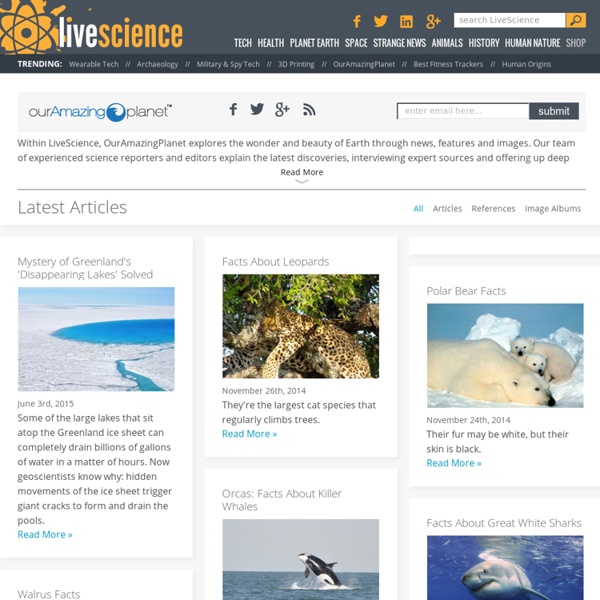



Places About Places The world is full of interesting places, each filled with weird and wonderful life forms. Some are on the other side of the world, while others are just down the street! iNaturalist.org Places are a way to record what lives where. Species from around the world Each place page displays all the species iNaturalist.org knows about from that place, including information about their abundance, conservation status, and who was first to observe that species from that place on iNaturalist.org. Localized species accounts View photos, species ranges, iNat observations, and more! Click the map to jump to a new place Blue icons represent political units like countries, states, provinces, counties, and the like, while green icons represent different kinds of open space (parks, reserves).
World Sunlight Map Watch the sun rise and set all over the world on this real-time, computer-generated illustration of the earth's patterns of sunlight and darkness. The clouds are updated daily with current weather satellite imagery. The Mercator projection used here is one way of looking at the spherical earth as a flat map. Used since the 16th century for navigation, straight lines on this map can be used accurately as compass bearings but the size and shape of continents are distorted. Also available is a semi-realistic view of dawn and dusk from far above the Earth, a look at the moon, and information about how this works.
Reference, Facts, News - Free and Family-friendly Resources - Refdesk.com Index of / TERRA: The Nature of Our World *Video Podcast* :: Home India is building Solar Canals to Produce Energy while Slowing Water Loss Gandhinagar, April 23: Close on heels of commencing use of wastelands in northern districts and rooftops in towns and cities, Gujarat is set to potentially use the existing 19,000 km-long network of Narmada canals across the State for setting up solar panels to generate power. The Chief Minister, Mr Narendra Modi, will inaugurate the first of a series of this project, known as Canal Solar Power Project, when he launches a 1 megawatt (mw) pilot project, which is already commissioned, on Narmada branch canal near Chandrasan village of Kadi taluka in Mehsana district on Tuesday. Last week, he inaugurated a 600-MW solar power project spread across 11 districts. Gujarat, which invests nearly Rs 2,000 crore an year on renewable energy, has attracted investments of Rs 9,000 crore so far on solar energy projects. Energy, water security Today, Gujarat has about 458 km of open Main Canal, while the total canal length, including sub-branches, is about 19,000 km at present. Related:
Bites Here's how to make Al Roker's famous cold-brew coffee Al's cold-brew coffee has been the talk of the show this week. Slightly sweet with notes of chicory,... How to avoid weight gain during the holidays, the easy way Nutritionist and health expert Keri Glassman shares her top tips for avoiding weight gain during... Eggnog all day every day! These quick recipe swaps make it easy to make eggnog a part of your balanced breakfast...or dessert...or... Impress your guests with Italian desserts (Nutella cake!) For a fabulous holiday celebration, match up Nutella cake with an espresso martini, plus an orange... 15 Christmas dinner ideas so you can plan your menu now The holidays are stressful. Decorate holiday cakes, pies and drinks with easy sugared cranberries You only need 4 ingredients to make these beautiful sugared cranberries that are a lovely finishing... The top 10 yummy food gifts you can mail to your friends this year Want to treat your friends to something delicious for the holidays?
99 Resources to Research & Mine the Invisible Web College researchers often need more than Google and Wikipedia to get the job done. To find what you're looking for, it may be necessary to tap into the invisible web, the sites that don't get indexed by broad search engines. The following resources were designed to help you do just that, offering specialized search engines, directories, and more places to find the complex and obscure. Search Engines Whether you're looking for specific science research or business data, these search engines will point you in the right direction. Turbo10: On Turbo10, you'll be able to search more than 800 deep web search engines at a time. Databases Tap into these databases to access government information, business data, demographics, and beyond. GPOAccess: If you're looking for US government information, tap into this tool that searches multiple databases at a time. Catalogs If you're looking for something specific, but just don't know where to find it, these catalogs will offer some assistance. Directories
TODAYMoms Ryan McVay / Getty Images stock FIONA GOODALL / AFP - Getty Images